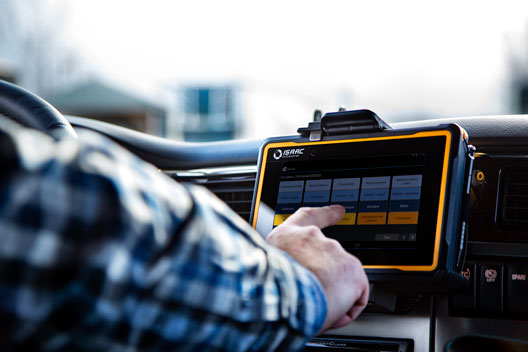Unless there is a dramatic turnaround, the requirement to switch to electronic logbook driving time management systems in the United States will take effect on December 2018. Transporters, drivers, but also dispatchers, will have to get used to this new reality, if they have not already deployed a system recognized and accepted by the authorities across the globe, and as in many cases, faced with new regulations, it’s a bit of a race against the clock. But are the fears and concerns raised by the imposition of the electronic logbook justified?
Two options are currently available to move from paper to the electronic age for “logbooks”: systems called in English AOBRD, or ELD, for Electronic Logging Device. The American transport safety agency, or FMCSA, allows another two years, from December 18, to use the earlier AOBRD technology, which is simpler and less restrictive. But from December 18, a carrier will no longer be able to install a new AOBRD device in a new truck. At most, he will be able to transfer an AOBRD currently in operation in a truck to a replacement truck. If it is an addition to the fleet and not a replacement, the transporter must choose an ELD system. And from December 2019, all must use ELDs. We have deployed our electronic logbook for truckers, in AOBRD form for three and a half years explains by authorities. All of our customers will probably take advantage of AOBRD mode during the grandfather clause as much as possible because it is much less restrictive for their operation.
Less restrictive, inter alia due to the fact those movements in the couriers of senders or recipients are not calculated and recorded as strictly as with the Electronic Logging Device. No court movement speed was set for AOBRD, while it was set at 8 km / h for ELD. I have drivers who have been using it since January and it’s going well. It always depends on where you deliver. If you can sleep at the client’s house, that solves half of the problems, because you don’t need to open your logbook to go to his house in the morning. This is where we have been working a lot for a year. Each time we take on new clients, we ask if our driver will be able to sleep on site. I am not saying that we refuse the client if this is not the case, but we are currently reflecting on many things.Annie Fortin pointed out that the main uncertainty is linked to the collaboration of senders and recipients. Waiting times too long to load or unload can indeed cause major upheavals on certain routes. According to her, the shippers have not been sufficiently sensitized, and are not ready.
As for Geotab, supplied in particular by AttriX in Quebec, we chose to anticipate the regulations and offer the Electronic Logging Device version earlier. Yes, recognizes expert, the ELD is more stringent than the AOBRD. However, the company has bet on the fact that many carriers would opt for the new standard to avoid ending up with two systems configured differently at the same time, which will be the case for a carrier who acquires new trucks to grow his fleet. This is one of the criteria that led experts of Transport Bourassa to choose the ELD solution from Geotab.
The suppliers of AOBRD and Electronic Logging Device seem unable to support both modes simultaneously. We buy several trucks per year, and some are additions to our fleet. We tested nine different solutions. And after doing the tests, we realized that there was not a big difference in saving time. For our type of LTL operation, what matters most is the 14 hours of service. Our drivers arrive regularly at 14 hours of work before reaching the maximum driving hours, and in this situation, the AOBRD versus the ELD does not give more advantages. The calculation of delivery times is an advantage for carriers who make numerous deliveries on the same route. Since the ELD (and the AOBRD) calculate downtime to the nearest second instead of doing it in 15-minute increments as is the case on paper, there are gains to be made here in driving hours.


